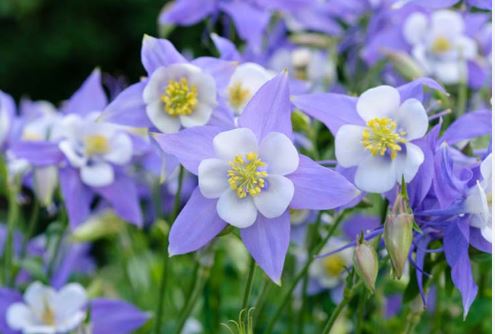
Aquilegia caerulea, commonly known as the Rocky Mountain Columbine or Colorado Blue Columbine, is part of the Aquilegia genus within the Ranunculaceae family, which is known as the buttercup or crowfoot family. This species is distinguished by its showy, spurred flowers, with the name “caerulea” indicating its blue color, although the flowers can also appear in shades of white, pink, and lavender. The genus name “Aquilegia” comes from the Latin for “eagle,” as the spurs resemble an eagle’s claw.
Rocky Mountain Columbine is native to the Rocky Mountains of North America, specifically found in the states of Colorado, Idaho, Montana, Utah, Wyoming, and extending into parts of New Mexico and South Dakota. It naturally occurs in mountainous regions, often at elevations between 6,000 to 12,000 feet, thriving in moist, well-drained soils in open woodlands, meadows, and along streamsides.
Historically, Aquilegia caerulea has been cherished for both its beauty and cultural significance. It was designated as the state flower of Colorado in 1899, symbolizing the state’s natural beauty and its mountain heritage. Native American tribes used the plant for medicinal purposes, including treatments for fevers and other ailments. Its popularity in horticulture grew due to its ornamental value, with hybrids and cultivars developed for garden settings. The flower’s delicate appearance and the unique shape of its blooms have made it a favorite in both wild and cultivated landscapes, often celebrated in art and literature.
This species suits USDA Hardiness Zones 3 through 8, reflecting its adaptability to the cold winters and variable conditions of high-altitude environments. As for its lifespan, Rocky Mountain Columbine is a short-lived perennial, typically lasting 3 to 5 years in the garden, though it freely self-seeds, ensuring its presence in subsequent seasons. Its natural habitat’s harsh conditions might contribute to its relatively short lifespan in cultivation, but with proper care, it can persist and even naturalize in suitable garden settings.
Rocky Mountain Columbine (Aquilegia caerulea): Characteristics
- Flower Appearance: Features large, showy flowers with long, backward-pointing spurs that can be blue and white, though variations include white with lavender or pink. Each flower has five sepals and five petals, creating a distinctive, star-like appearance.
- Bloom Time: Blooms in late spring to early summer, providing one of the first vibrant floral displays in high-altitude gardens or natural settings after the snow melts.
- Growth Habit: Grows as a herbaceous perennial with a clumping habit, reaching heights of 1 to 3 feet. It has an upright, sometimes slightly spreading growth form.
- Leaves: Leaves are compound, with three main leaflets further divided into smaller lobes, giving them a lacy, fern-like appearance. They are green and basal, with smaller leaves along the stems.
- Root System: Has a fibrous root system that helps anchor it in rocky or well-drained soils but also allows for easy transplanting when young.
- Adaptability: Thrives in well-drained, moist soil but can adapt to a range of conditions, preferring partial shade to full sun at higher elevations where sun exposure is less intense.
- Pollinator Attraction: Attracts hummingbirds, bees, and butterflies with its nectar-rich flowers, playing an important role in pollination, especially in its mountainous habitats.
- Fragrance: While not particularly noted for fragrance, the flowers can have a slight, sweet scent, adding a subtle sensory experience to its visual appeal.
- Self-Seeding: Known for self-seeding, which can lead to naturalization in gardens or landscapes where it’s well-suited, ensuring new plants appear even after the original has completed its lifespan.
- Ecological Role: Provides habitat and food for wildlife, especially pollinators, and contributes to the biodiversity of its native high-altitude ecosystems. Its growth in varied conditions helps stabilize soil in mountainous regions.
Rocky Mountain Columbine (Aquilegia caerulea): Cultivation
Site Selection
Choose a site with partial shade to full sun, especially at lower elevations where full sun can be intense. It appreciates some afternoon shade in warmer climates.
Soil Preparation
Prefers well-drained, loamy soil rich in organic matter. Amend heavy or sandy soils with compost to improve both drainage and moisture retention.
Planting
Plant in spring or fall. Sow seeds directly or transplant seedlings, spacing them about 1 to 2 feet apart to allow for growth and air circulation. Seeds benefit from cold stratification, mimicking winter conditions.
Watering
Water regularly after planting to establish roots, especially if starting from seeds. Once established, it’s somewhat drought-tolerant but performs best with consistent moisture, particularly during blooming.
Mulching
Use a light layer of organic mulch to help retain soil moisture, suppress weeds, and provide nutrients as it decomposes. Keep mulch away from the plant’s crown to prevent rot.
Fertilization
Fertilize sparingly; too much can lead to lush foliage at the expense of flowers. A light application of a balanced, slow-release fertilizer in early spring might be beneficial.
Pruning and Maintenance
Deadhead spent flowers if you wish to prevent self-seeding or extend the blooming period, but leave some seed heads for natural reseeding. Remove any dead foliage in late fall or early spring.
Pest and Disease Management
Generally pest-resistant, but watch for leaf miners, aphids, or fungal diseases in overly moist conditions. Good air circulation and avoiding overhead watering can prevent most issues.
Propagation
Easily propagated by seed, which can be sown in fall or stratified for spring planting. Division is less common but possible in spring, or take basal cuttings in late winter or early spring.
Winter Care
In its hardiness zones, no special winter care is needed as it’s quite hardy. However, in colder zones or harsher winters, a light mulch can protect the roots.